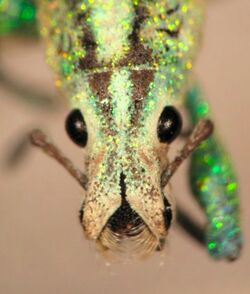Biology:Oxyderces
| Oxyderces | |
|---|---|

| |
| Head of Oxyderces sp. | |
| Scientific classification | |
| Kingdom: | Animalia
|
| Phylum: | |
| Class: | |
| Order: | |
| Family: | |
| Subfamily: | |
| Tribe: | |
| Genus: | Oxyderces Schönherr, 1823
|
Oxyderces is a genus of broad-nosed weevils in the family Curculionidae distributed in South America. It can be recognized by the presence of dense setae on the apex of the rostrum and postocular setae.
Taxonomy
The genus was named for the first time by Carl Johan Schönherr in 1823 in column 1140.[1] It belongs to the subfamily Entiminae, tribe Eustylini.
It belongs to the so-called "Compsus genus complex". It has been proposed that Oxyderces is a synonym of Compsus.[2]
Description
In 1922 Sir Guy A. K. Marshall described the genus Plococompsus,[3] which is currently a synonym of Oxyderces.[4][5] This reference presents a good diagnosis for the genus:
This genus is proposed for a small homogeneous group of species of Compsus that are characterised especially by the presence of postocular vibrissae on the prothorax. Other characters are as follows: Scrobes narrow, curved downwards, but the upper edge attaining about the middle of the eye, so that the scape at rest passes across the lower half of the eye; the bare part of the scrobe not sharply defined, but gradually clothed with scales behind; epistomal setae very long and dense; scape not or only slightly exceeding the eye, comparatively slender, clavate, squamose, with the scales not overlapping; mentum with a group of setae on each side; insects with functional wings.
Distribution
Oxyderces is known from Argentina , Bolivia, Brazil , Colombia, Ecuador, Paraguay, Peru, Venezuela; Guadeloupe, Martinique.[4]
Species list
The following species have been assigned to this genus:[5]
- Oxyderces argentinicus (Heller, 1921: 28):[6] Argentina .
- Oxyderces bimaculatus (Hustache, 1923: 290):[7] Argentina , Bolivia.
- Oxyderces cinereus (Hustache, 1938: 110):[8] Ecuador.
- Oxyderces cretaceus (Fabricius, 1792: 452):[9] Guadeloupe, Martinique.
- Oxyderces croesus (Faust, 1892: 11):[10] Venezuela.
- Oxyderces dubius (Voss, 1932: 40):[11] Paraguay.
- Oxyderces euchloris (Pascoe, 1880):[12] Peru.
- Oxyderces exaratus (Hustache, 1938: 111):[8] Colombia.
- Oxyderces mansuetus Hustache, 1938: 109:[8] Argentina .
- Oxyderces mirandus (Pascoe, 1880: 423):[12] Colombia, Ecuador. [synonyms:[13][5] Oxyderces cicatricosus (Hustache, 1938),[8] Oxyderces nigroundulatus (Hustache, 1938),[8] Oxyderces texatus (Hustache, 1938) [8]]
- Oxyderces sinuatocostatus (Hustache, 1938: 112):[7] Brazil .
- Oxyderces tarapotae (Hustache, 1938: 113):[8] Peru.
- Oxyderces viridiaeris (Hustache, 1938: 115):[8] Colombia.
- Oxyderces viridipes (Boheman, 1840):[14][2] Colombia.
References
- ↑ Schönherr, C. J. (1823). Curculionides [Tabula synoptica familiae Curculionidum]. Isis von Oken. pp. 1132–1146. https://biodiversitylibrary.org/page/13257284.
- ↑ 2.0 2.1 Girón, J. C.; Chamorro, M. L. (2020-09-07). "Variability and distribution of the golden-headed weevil Compsus auricephalus (Say) (Curculionidae: Entiminae: Eustylini)" (in en). Biodiversity Data Journal 8: e55474. doi:10.3897/BDJ.8.e55474. ISSN 1314-2828. PMID 32733144.
- ↑ Marshall, Guy A. K. (1922). "VI. On New Genera and Species of Neotropical Curculionidae". Transactions of the Entomological Society of London 70 (1–2): 181–224. doi:10.1111/j.1365-2311.1922.tb02830.x. https://www.biodiversitylibrary.org/part/31573.
- ↑ 4.0 4.1 Alonso-Zarazaga, M. A.; Lyal, C. H. C. (1999). A world catalogue of families and genera of Curculionoidea (Insecta: Coleoptera) excluding Scolytidae and Platypodidae. Barcelona, Spain: Entomopraxis. pp. 315 pp. https://weevil.myspecies.info/sites/weevil.info/files/Alonso-Zarazaga%20%26%20Lyal,%201999_World%20Catalogue%20%28searchable%29.pdf.
- ↑ 5.0 5.1 5.2 Wibmer, G. J.; O’Brien, C. W. (1986). "Annotated checklist of the weevils (Curculionidae sensu lato) of South America (Coleoptera: Curculionoidea)". Memoirs of the American Entomological Institute 39: 1–563.
- ↑ Heller, K. M. (1921). "Nuevos Curculiónidos de la Argentina". Anales de la Sociedad Científica Argentina 91: 19–35. https://www.biodiversitylibrary.org/part/168797.
- ↑ 7.0 7.1 Hustache, A. (1923). "Curculionides de l'exploration Lizer-Deletang au Chaco Bolivien". Anales de la Sociedad Científica Argentina 96: 279–300. https://www.biodiversitylibrary.org/part/168856.
- ↑ 8.0 8.1 8.2 8.3 8.4 8.5 8.6 8.7 Hustache, A. (1938). "Compsus sud-américains (Coleoptera Curculionidae)". Bulletin de la Société Entomologique de Belgique 78: 67–118.
- ↑ Fabricius, J. C. (1792). Entomologia systematica emandata et aucta. Secundum classes, ordines, genera, species adjectis synonimis, locis, observationibus descriptionibus. 1. Hafniae: impensis Christ. Gottl. Proft. pp. 538. https://www.biodiversitylibrary.org/item/219086.
- ↑ Faust, J. (1892). "Reise von E. Simon in Venezuela. Curculionidae. Pars prima". Entomologische Zeitung 53: 1–44. https://www.biodiversitylibrary.org/part/101192.
- ↑ Voss, E. (1932). "Unbeschriebene neotropische Curculioniden. I. (35. Beitrag zur Kenntnis der Curculioniden)". Revista de entomologia. Rio de Janeiro 2 (1): 33–43.
- ↑ 12.0 12.1 Pascoe, F. P. (1880). "New Neotropical Curculionidae. Part I". The Annals and Magazine of Natural History 5 (29): 419–428. doi:10.1080/00222938009459433. https://biodiversitylibrary.org/page/16336574.
- ↑ Kuschel, G. (1955). "Nuevas sinonimias y anotaciones sobre Curculionoidea". Revista Chilena de Entomología 4: 261–312. http://www.insectachile.cl/rchen/pdfs/1955v04/Kuschel_1955b.pdf.
- ↑ Schoenherr, C. J.; Boheman, C. H.; Fåhraeus, Olof Immanuel; Gyllenhal, L. (1833). Genera et species Curculionidum, cum synonymia hujus familae species novae. Paris: Roret. pp. 474. https://www.biodiversitylibrary.org/bibliography/5060.
Wikidata ☰ Q14924342 entry
 |

